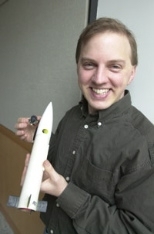The Lemelson-MIT Program held a press conference last week to present Andrew Heafitz, a graduate student in mechanical engineering, with the $30,000 Lemelson-MIT Student Prize.
The 32-year-old Heafitz accepted the award in front of about 50 reporters, photographers, TV camera crews and well wishers at the Faculty Club, including his parents, whom he thanked for their support.
"And I thank my father for not getting mad at me when I took the lawnmower apart to see how it worked without remembering how to put it back together," said Heafitz, who comes from Newton.
The judges selected Heafitz for his "ingenuity and remarkable inventiveness." Most notable among his inventions are several aerial photography systems and a rocket engine.
AERIAL PHOTOGRAPHY
Heafitz, who said he was influenced by the work of Doc Edgerton, spent two years in high school designing and building a balsa wood motor-driven camera so that he could launch it in a rocket and get better aerial shots. The camera takes 60 frames in six seconds.
His undergraduate thesis project was a balloon photography system with a Nikon camera attached to a helium balloon. He had already built a similar system in high school. His balloon systems were used on an archaeological expedition in Greece and to help recover a pirate ship, the Whydah, that sank in 1716 off the coast of Cape Cod.
"When I called Andrew to invite him to this event, he said 'No. I'm too busy.' He said he had to search for buried pirate's treasure," said Robert Lemelson, the son of inventor Jerome H. Lemelson, who established the Lemelson-MIT program with his wife, Dorothy, in 1994.
Heafitz earned his bachelor's degree from MIT in 1991, then worked as a product design consultant and an electric car designer before returning to MIT for graduate studies in 1998. He earned his master's degree in 2001 and expects to complete his doctorate in 2005. Last year he started a company, TacShot, to produce a low-cost aerial surveillance system he designed.
Heafitz's company sells an aerial surveillance system "the size of a Coke can" that creates a 360-degree panoramic view. The system uses a commercially available video camera and a tiny transmitter to send images to a computer that puts them together into a cohesive panoramic view. Heafitz hopes to sell the system to the United States Army.
"I'm not trying to invent aerial photography, just do it cheaper," said Heafitz, who told the audience he intended to use the prize money to help TacShot and fund other inventions. "I'm very proud to be considered one of MIT's most innovative students. I used to have the motto, 'strive to be average' as an undergraduate at MIT because there were so many brilliant students around."
NOVEL ROCKET ENGINE DESIGN
A member of the MIT Rocket Team, Heafitz helped build a low-cost rocket engine fueled by kerosene and liquid oxygen that uses an electric motor to spin the fuel pump up to the speed needed to ignite the engine. The pump's location inside the combustion chamber of the engine is a novel design created by Heafitz and Carl Dietrich, a graduate student in aeronautics and astronautics. The electric motor, which came from a solar car Heafitz was familiar with, also will serve as a dynamometer to determine if the pump is producing enough power for the engine to sustain itself.
"I have watched Andrew develop incredibly resourceful solutions, drawing together ideas and techniques from a wide spectrum of engineering," said John Keesee, a senior lecturer in aeronautics and astronautics who advises the rocket team. "He is unusually prolific, an outstanding inventor and fully deserving of this award."
If the engine passes a test firing later this month, the team will use it to power a rocket of its own design into space. Heafitz, who is a founder and co-leader of the team, hopes the rocket's cargo, a set of video cameras taking a 360-degree panorama, will provide a virtual reality exhibit at the Boston Museum of Science.
Some of Heafitz's other inventions are not only low-cost, but low-tech as well, making them appropriate for use in developing countries. One, a demining device powered by a chain-saw engine, uncovers landmines quickly and safely.
Another is a mechanical gas leak detection device that signals the contamination of ground water surrounding gas storage tanks. The spherical device is equipped with two small, colored flags at its center: red signifies contamination, green means all-clear. Heafitz said that 300 of the devices have been delivered for testing in South America and that a major petroleum company plans to order 50,000 to monitor wells in developing countries.
LEMELSON-MIT PROGRAM
The Lemelson-MIT Program, funded by the Lemelson Foundation, celebrates inventor/innovator role models through outreach activities and annual awards, including the world's single largest prize for invention, the $500,000 Lemelson-MIT Prize. The program encourages young Americans to pursue careers in the fields of science, engineering, technology and entrepreneurship. Last fall, the program and MIT Press released "Inventing Modern America: from the Microwave to the Mouse," an illustrated book that profiles 35 American inventors who helped shape the modern world.
A version of this article appeared in MIT Tech Talk on March 13, 2002.






